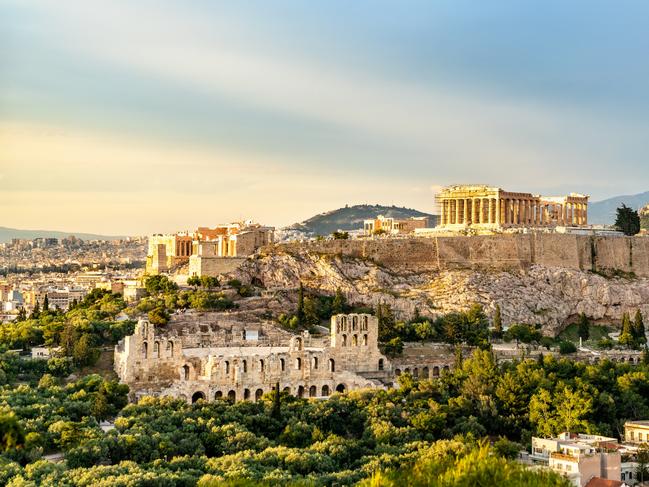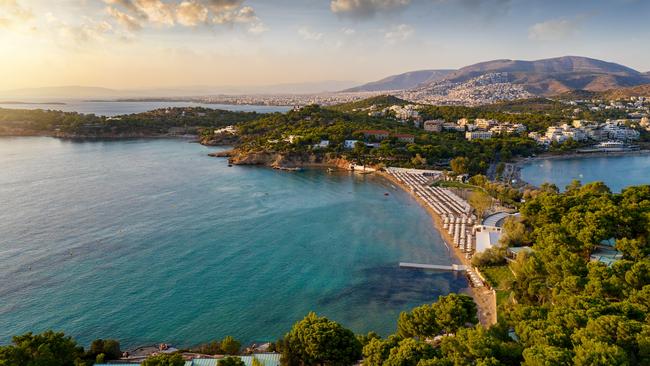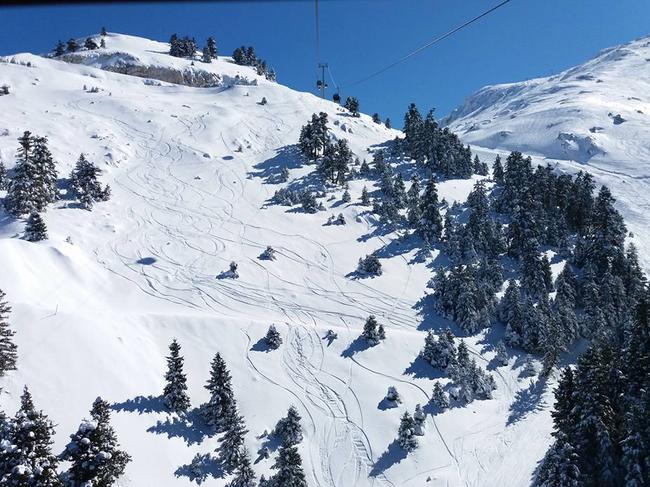Acropolis now: travel to Greece in winter to beat the crowds
Skip the summer hordes and try visiting Greece out of season.

It’s July in Athens, and I’m quite certain the whole of Europe has decided to join me on a visit to the Acropolis. Movement towards the hilltop Parthenon is painfully slow; the snaking queues, relentless sun and lack of shade all rub some of the lustre off what should be one of the most magical experiences in Greece. I thought arriving at 9am would spare me the heat of this summer’s day, but I’ve barely reached the top and am already in need of a shower and a change of clothes.
The ancient Acropolis citadel, the most important of its kind in the Western world, sits proudly above the city, its white Pentelic marble gleaming brightly during the day, then brilliantly illuminated at night. It’s no wonder the landmark and its associated museum attracted more than 4.5 million people in 2018, with most tourists making the pilgrimage over the warmer months.
MORE TRAVEL: Central Asia’s greatest road trip | Sublime temples and divine interactions on a tour of southern India | Even the tranquil setting of this pioneering Phuket resort is therapeutic
According to the Greek Trade Commission, the country had in excess of 33 million international visitors that year, three times the domestic population. The Australian contingent is strong, with about 320,000 of us touching down in the country in 2017, double the figures recorded for the previous year. Aussies are favoured guests in Greece, if only because we’re at the top of the table for spending over the course of our stay. Like most travellers, we mainly visit in July; close to four million foreigners travelled to Greece during that month last year.
No other major European country has seen a bigger increase in visitor numbers this decade, with tourism accounting for about 25 per cent of Greece’s GDP. The rapid rise is having a major impact on infrastructure and attractions over the peak summer months. The Greek National Tourism Organisation says it is aware of the problems, and is focusing on extending the summer season and developing thematic tourism that can attract visitors all year round.

Autumn awakening
And so, I return to Athens one November and get a completely different perspective. I barely remember the sweaty encounters my last summer stay inspired. There is space to take photos of the Acropolis while lingering over seemingly endless city views. If I were here on the first Sunday of the month from November 1 to March 31, my admission to this UNESCO World Heritage site would be free. It’s an initiative applied to a number of Greece’s historical attractions at this time of the year, to encourage visitation outside summer.
I can watch the changing of the guard at Syntagma Square in Athens without having to strain to catch a glimpse of the theatrical parade over the heads of crowds. And I slip into achingly cool wine bars in the Plaka neighbourhood, scoring a table despite not having a reservation.
Late autumn is my favourite time in Athens, when the weather cools but there’s still enough sunshine to inspire wanderings through the enchanting historic districts that surround the Acropolis. I refuel on koulouri (a ring of sesame seed-covered bread) from one of the many food carts that ply the streets, and amble through Alsos Park in Pangrati, one of the city’s up-and-coming suburbs. It’s also home to a cache of forward-thinking galleries and quirky bars such as Superfly Cafe, with its head-turning collection of tchotchkes and vintage curios.
There’s also a reason to head south from the city to Astir Beach, which locals refer fondly to as the Athenian Riviera. If it has glam connotations, that’s because it has a glam history. Brigitte Bardot and Frank Sinatra used to frequent this pretty peninsula when they visited town and checked in to the Astir Palace Resort.
The property was recently taken over by Four Seasons, which last year opened a no-expense-spared retreat where you can take a dip in the ocean or one of the many pools, and then order cocktails and prawn tacos at the beach club. Only the brave swim here in winter (average daytime temperatures range between 13C and 15C), but there’s still plenty of sunlight for waterside hangouts, and there’s also an indulgent spa for facials and massages.

Saturation point
The most popular of Greece’s islands, Santorini lures vast numbers of holidaymakers to its spectacular sunsets and seascapes. According to a recent report by the European parliament’s transport committee, visitor arrivals went up by 66 per cent between 2012 and 2017, from 3.3 million to 5.5 million. But the island is just 76km sq — you could fit about eight Santorinis into Singapore — and traffic jams and overcrowding have become an issue, as has rising water and energy consumption.
The pressure on resources is especially evident in Oia, where whitewashed houses and windmills tumble down the cliff towards the caldera. Trying to capture a summer sunset here means copping a few elbows to the ribs, with selfie stick-obsessed tourists jostling for space in rooftop bars and at lookouts. It’s like a game of dodgeball for weary hotel porters, lugging suitcases along the same cobbled streets, navigating crowds to reach vertiginous retreats with no road access.
Nikos Zorzos, the island’s mayor, has warned that Santorini is at “saturation point”, and recently put a daily cap on cruise passengers to stem the tide of tourists; they are now limited to 8000 a day, down from 12,000 in previous years. The island has also tried to spread ship arrivals throughout the day to ease the burden and minimise sunset surges in popular villages.
Island idylls
Unlike Santorini, many of Greece’s islands are sleepy even during peak season, let alone over the winter. On a recent visit to the Cycladic islet of Kimolos during August, it took the best part of a day to find a restaurant that was open and serving more than one dish. When the cooler weather comes, Kimolos, like many others islets across the archipelago, shuts down completely, with locals either hibernating or migrating to Athens to work and visit family.
Many of the more popular island destinations, such as Santorini and Crete, simply scale back operations from November through March. This means you won’t have every island resort and restaurant at your disposal if you visit at this time, but you will be able to sleep and eat comfortably, and you will be able to do this without having to book a year in advance and pay astronomical summer prices. Savings of about 30 per cent are standard in the shoulder season (April to mid-June, mid-September through October), and rates drop even further at resorts staying open over December, January and February. And there are quite a few.
Former Greek tourism minister Elena Kountoura says more than 100 Santorini hotels welcomed visitors during the winter 2016-17 season. “It was a big success, and it is an example how you can manage so well to spread all these tourists during 365 days a year in order to eliminate the problem of overtourism,” she says.
More to the story
In addition to encouraging tourists to visit all year round, Greece’s tourism board is also promoting lesser-known Greek destinations, such as other islands in the Cyclades, as well as other destinations in the north.
During the winter months one popular haunt is the Parnassos Ski Centre, Greece’s largest ski resort, about 170km northwest of Athens. Once checked in to a boutique hotel in the mountain village of Arahova, you can flit between the slopes and rustic tavernas warmed by log fires.

Day trips from here include the hillside archaeological site of Delphi, especially magical when dusted with snow (similar to the Acropolis, there are days in winter when entrance fees are waived).
Almost directly north of Athens on a bend of the Aegean Sea is the country’s cultural capital, Thessaloniki. This was the wealthiest city of the Byzantine Empire, and its charms range from historic churches and centuries-old ruins to Ottoman-era relics. Most of these sites are usually tourist-free — not for want of attractiveness, but because you have to travel about 500km to get there from Athens. The commute is worth it.
Also to the north are the Pozar Thermal Baths, a series of soothing baths, pools, hammams and jacuzzis that promise to cure what ails you. Amid a rugged snow-capped landscape, the River Toplitsa creates natural hot springs, waterfalls and steamy pools of therapeutic waters. Before a soak, hit the trails connecting the thermal springs with Mount Voras, explore 16 prehistoric caves hidden in a gorge, wander through the nearby Black Forest or go bird watching.
Then there are the wineries, clifftop monasteries and forests full of hiking trails.
Greece outside summer never looked so good.

To join the conversation, please log in. Don't have an account? Register
Join the conversation, you are commenting as Logout